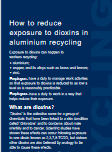FREE Quality, Health and Safety, and HR Business Software Click <HERE> to Learn More and Download
THIS SITE CONTAINS NO GOOGLE OR SIMILAR TYPE ADS and NO CLICK BAIT LINKS
QHSE Support >(Site Map) Health & Safety Guidance > H&S INDGs - Industry Guides >
Useful INDG Health and Safety Guides - page 3
Health and Safety Executive
INDG is an Acronym for Industry Guidance
Health and Safety INDG Industry Guides 305 to 399
> INDG 305 - Lead and you
> INDG 310 - Drycleaners - Are you in control?
> INDG 311 - Beryllium and you
> INDG 314 - Hot work on small tanks
> INDG 316 - Inspection and testing of mechanical power presses and press brakes
> INDG 317 - Chainsaws at work
> INDG 318 - Manual handling solutions in woodworking
> INDG 327 - Working safely with acetylene
> INDG 329 - Bezene and you
> INDG 330 - Selecting protective gloves
> INDG 331 - Safe use of petrol in garages
> INDG 334 - Working safely with ionising radiation
> INDG 335 - Is it Explosive
> INDG 339 - Thorough examination and testing of lifts
> INDG 342 - Latest Titles Blood-borne Viruses In The Workplace
> INDG 344 - The Absolutely Essential Health and Safety Tool Kit for the Smaller Construction Contractor
> INDG 345 - Health and safety training
> INDG 346 - Chromium and you
> INDG 347 - Basic advice on first aid at work
> INDG 349 - Safe working with vehicle air-conditioning systems
> INDG 351 - Nickel and you
> INDG 354 - Safety in electrical testing at work
> INDG 356 - Reducing ill health and accidents in motor vehicle repair
> INDG 360 - Health and safety in audio-visual
> INDG 361 - Regulating health and safety in the UK offshore oil and gas fields
> INDG 362 - Noise : Noise at Work 2005 - Guidance for Employers
> INDG 363 - Noise : Protect your Hearing or Lose it
> INDG 365 - Working safely with metalworking fluids
> INDG 367 - Inspecting fall arrest equipment made from webbing or rope
> INDG 368 - Using contractors
> INDG 370 - Controlling fire and explosion risks in the workplace
> INDG 371 - The safe operation of ski slopes
> INDG 372 - Electrical switchgear safety
> INDG 377 - How to reduce exposure to dioxins in aluminium recycling
> INDG 378 - Safe use of skip loaders
> INDG 379 - In road haulage
> INDG 382 - Road Safety - Managing Work Related
> INDG 383 - Manual handling assessment charts (the MAC tool)
> INDG 384 - Five ways to reduce risk on site
> INDG 387 - Safe working with LPG-fuelled motor vehicles
> INDG 388 - Safety in isocyanate paint spraying
> INDG 390 - Choosing a welding set?
> INDG 391 - Cadmium and you
> INDG 392 - Guidance for the recover paper
> INDG 398 - Making the best use of lifting and handling aids
> INDG 399 - Managing sickness absence and return to work in small businesses

INDG 305 Lead and you
Working safely with lead Working with lead can affect your health. This leaflet tells you about:
•health problems that can occur if you absorb too much lead;
•what your employer should do to protect your health;
•precautions you should take.
When are you most at risk?
When the work you are doing produces lead dust, fume or vapour you are most at risk. This can include:
•blast removal and burning of old lead paint;
•stripping of old lead paint from doors, windows etc;
•hot cutting in demolition and dismantling operations;
•scrap-processing activities, including recovering lead from scrap and waste;
•lead-acid battery manufacture, breaking and recycling;
•some painting of buildings;
•some spray-painting of vehicles;
•working with metallic lead and alloys containing lead, eg soldering;
•lead smelting, refining, alloying and casting;
•manufacturing and physically processing (eg bagging) lead compounds;
•manufacturing leaded glass;
•manufacturing and using pigments, colours and ceramic glazes;
•recycling of any materials containing lead (eg cables, TVs or computer monitors containing cathode ray tubes (CRT)).

INDG 310 Drycleaners - Are you in control?
Introduction
This leaflet highlights ways in which drycleaning businesses may affect people’s health and safety and gives advice on how to reduce risks.

INDG 311 Beryllium and you
Working with beryllium and its compounds may affect your health. This leaflet tells you about the possible health effects, the preventative measures your employer needs to apply, and the precautions you should take.
What is beryllium?
Beryllium is a lightweight, strong, steel-grey metal, and its oxide (beryllia) is a hard, white ceramic. Copper/beryllium alloys are 97% copper, containing up to 3% beryllium.

INDG 314 Hot work on small tanks
This leaflet is for people who cut up or repair tanks, drums or other containers. It provides information on the fire and explosion hazards and how to reduce the risks.
Hot work is any process that generates flames, sparks or heat. It includes welding, cutting, grinding and sawing.
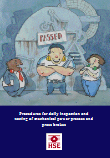
INDG 316 Procedures for daily inspection and testing of mechanical power presses and press brakes
INTRODUCTION
This leaflet gives guidance on the minimum safety checks that should be carried out on mechanical power presses and press brakes by the appointed person, as required by regulation 33 of the Provision and Use of Work Equipment Regulations 1998 (PUWER 1998). It does not apply to hydraulic presses or those presses exempted from the requirements of regulation 33 as detailed in Schedule 2 in PUWER 1998. These may still require inspection in accordance with regulation 6 of PUWER.
The daily inspection and test must be done on each press in use within the first four hours of every working period and after setting, resetting or adjustment of the tools when any of the guards or protection devices have been disturbed.

INDG 317 Chainsaws at work
Introduction
This leaflet gives guidance on using portable, hand-held, petrol-engine chainsaws at work. It is aimed at employers, the self-employed and those who control the use of work equipment and includes basic information on safe working practices which operators may find useful.

INDG 318 Manual handling solutions in woodworking
Introduction
This leaflet describes what employers and others who have control of manual handling activities may need to do to protect their employees in the workplace. It will also be useful to employees and their representatives.
What are the problems?
In woodworking, manual handling causes approximately 30% of the work-related injuries reported each year. As well as the obvious strains and sprains, handling can also result in lacerations and fractures. Most injuries arise from stresses and strains over a period of time rather than from a single event and some result in permanent disablement.

INDG 327 Working safely with acetylene
This leaflet provides guidance on the fire and explosion hazards of acetylene. It is for people who use acetylene for welding, cutting and similar processes.
The leaflet does not cover fixed installations where acetylene is used (see www.hse.gov.uk/fireandexplosion/acetylene.htm for more information on these).

INDG 329 - Bezene and you
Working with benzene – are you at risk?
This leaflet is aimed at people who work with benzene. Working with benzene may affect your health. The leaflet tells you about the possible health effects, the preventative measures your employer needs to apply and the precautions you should take.
What is benzene?
Benzene is a highly flammable liquid, which occurs naturally in crude oil, natural gas and some ground waters. It is also present in crude oil vapours.
The main use of benzene is as starting material for manufacturing chemicals such as cyclohexane, ethyl benzene (styrene), phenol and maleic anhydride. It was formerly used as a solvent, but in most cases, safer substances have now replaced this use.
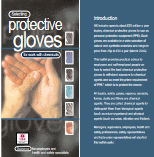
INDG 330 Selecting protective gloves
This leaflet provides practical advice to how to select the best chemical protective gloves to withstand exposure to chemical agents and so meet the prime requirement of PPE, which is to protect the wearer.

INDG 331 Safe use of petrol in garages
Introduction
Fires and explosions caused by careless handling of petrol during vehicle maintenance occur all too easily. Even small leaks and spills of petrol have the potential to escalate into a major incident.

INDG 334 Working safely with ionising radiation
Guidelines for expectant or breastfeeding mothers
Introduction
This leaflet provides advice for female employees who may be exposed to ionising radiation during their work. It is specifically aimed at those women who are thinking of having a baby or are already pregnant or breastfeeding.
Although occupational exposures during pregnancy are not a significant problem for female employees in Britain, the leaflet explains what you can do to safeguard your family and yourself.
The advice covers your employer’s normal duties under the Ionising Radiations Regulations 1999 and the additional requirements during pregnancy and breastfeeding. It also explains why it is important for you to let your employer know as soon as you are aware that you are pregnant

INDG 335 Is it Explosive
Who should read this?
This leaflet is for people who handle or process metals intended for recycling and which may contain explosive products. It provides information to help you identify if explosives are still present and how to keep the risks of an explosion and injuries to a minimum.

INDG 339 Thorough examination and testing of lifts
Introduction
The Lifting Operations and Lifting Equipment Regulations 1998 (LOLER) introduced new requirements for the safe provision and use of lifting equipment. Regulation 9 of LOLER requires that all lifts provided for use in work activities are thoroughly examined by a competent person at regular intervals. This applies to lifts and hoists used to lift people or loads.
If you are a lift owner or someone responsible for the safe operation of a lift used at work, such as a facilities manager or supervisor, you are a ‘dutyholder’ under LOLER. This means that you have a legal responsibility to ensure that the lift is thoroughly examined and that it is safe to use. (If you are the owner of a lift used primarily by members of the public, you may also find this guidance helps you to comply with more general health and safety legal duties under the Health and Safety at Work etc Act 1974.)

INDG 342 Latest Titles Blood-borne Viruses In The Workplace
Is this guidance useful to me?
If you are an employer or employee, self-employed or a safety representative, and involved in work where exposure to blood or other body fluids may occur, you should read this guidance. It will help you to understand:
•what blood-borne viruses (BBVs) are;
•the types of work where exposure to BBVs may occur and how BBVs are spread;
•the legal duties of employers and employees;
•the action to be taken after possible infection with a BBV;
•special considerations for first aiders
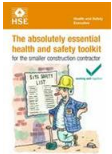
INDG 344 The Absolutely Essential Health and Safety Tool Kit for the Smaller Construction Contractor
This toolkit provides a ready checklist for health and safety problems on small construction sites. It will help you manage or avoid them and to ensure your own health and safety as well as the health and safety of the people who work for you, your clients, and others such as the public.

INDG 345 Health and safety training
This leaflet explains what you, as an employer, may need to do to ensure your employees receive appropriate health and safety training. It gives advice on who may need training, what form the training may take and how to organise it. The leaflet will also be useful to employees and their representatives.

INDG 346 Chromium and you
Introduction
Working with chromium and its inorganic compounds may affect your health. This leaflet tells you about the possible health effects, the preventative measures your employer needs to apply, and the precautions you should take to protect your health.
Not all forms of chromium present the same dangers. This leaflet focuses on chromium (VI) compounds.

INDG 347 Basic advice on first aid at work
This leaflet contains basic advice on first aid for use in an emergency. It is not a substitute for effective training.

INDG 349 Safe working with vehicle air-conditioning systems
This leaflet tells you about the main health and safety risks associated with work on air-conditioning systems in motor vehicles containing refrigerant chemicals R12 (‘Freon’) or R134a ('Tetrafluoroethane'). It includes information on how workers can be harmed, and the precautions that should be taken. The use of alternative refrigerants, for example during a retro-fit, may require additional precautions.

INDG 351 Nickel and you
Introduction
Working with nickel and its compounds may affect your health. This leaflet tells you about the possible health effects, the preventative measures your employer needs to apply, and the precautions you should take.
Not all forms of nickel present the same dangers – this leaflet will help you identify the specific hazards from the nickel in your workplace.
What is nickel?
Nickel is a silvery-grey metal. It is used mainly:
> in alloys with other metals;
> as its compounds, which are often a bright green colour.

INDG 354 - Safety in electrical testing at work
This leaflet is aimed at people who manage or carry out electrical testing, and gives guidance on controlling risks and preventing or reducing danger arising from these activities. You can find more detailed information about specific types of testing in other guidance.
Electrical testing may be carried out for a number of reasons, eg:
> quality assurance tests on electrical components;
> diagnostic testing;
> fault finding on electrical plant;
> routine safety checks.
The guidance supplements the information in HSG85 Electricity at work: Safe working practices.
HSG85 gives more general guidance to managers. It covers the key things to consider when devising safe working practices for people who carry out work on or near all types of electrical equipment.

INDG 356 Reducing ill health and accidents in motor vehicle repair
Introduction
This leaflet is aimed at anyone involved in motor vehicle repair and maintenance.
It covers the main causes of accidents and ill health and explains some of the precautions you can take to prevent them.
A checklist at the end of the leaflet will help you ask the right questions and prioritise your actions.
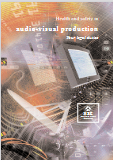
INDG 360 - Health and safety in audio-visual
INTRODUCTION
This leaflet is for those working in film, broadcast, video and commercials production. It should help them understand and comply with their legal duties in maintaining safety, whatever their role in the production process.
The leaflet explains the obligations and responsibilities of the investor/client, production company, producer, contractors, designers, suppliers and other workers. It also provides practical advice on competence, training, risk assessment and employment status.

INDG 361 - Regulating health and safety in the UK offshore oil and gas fields
WHO IS RESPONSIBLE FOR HEALTH AND SAFETY?
This leaflet is aimed at seafarers and offshore workers. It will tell you who is responsible for enforcing health and safety law and where you can obtain further guidance.
The Health and Safety Executive (HSE), the Maritime and Coastguard Agency (MCA) and the Marine Accident Investigation Branch (MAIB) are responsible for different aspects of the law applied to offshore oil
and gas.

INDG 362 - Noise : Noise at Work 2005 - Guidance for Employers
What is this leaflet about?
Loud noise at work can damage people’s hearing and lead to risks to safety. This leaflet explains what you, as an employer, need to do under the Control of Noise at Work Regulations 2005 to protect your employees from noise. It will also be useful to employees and their representatives.
This leaflet tells you about:
> the harm that noise can cause;
> the legal duties on employers;
> identifying if there is a problem with noise in your workplace;
> controlling noise and preventing harm.

INDG 363 - Noise : Protect your Hearing or Lose it
What is the problem with noise?
Noise is part of everyday life, but too much noise can cause permanent and disabling hearing damage. This can be hearing loss that gets worse over time, damage caused by sudden, extremely loud noises, or tinnitus (permanent ringing in the ears).
With hearing damage, conversation becomes difficult or impossible, your family complains about the television being too loud, you have trouble using the telephone, and you may be unable to sleep. By the time you notice, it is probably too late.
However, there is no need for your hearing to be damaged by your work – your employer has a duty to protect you and should be working on measures to reduce the risk. You can play a part in helping your employer to protect you.

INDG 365 - Working safely with metalworking fluids
Introduction
This leaflet aims to help employees who work with metalworking fluids understand the main risks to their health. It contains general advice on the precautions which you and your employer can take to avoid these risks.
What are metalworking fluids?
Metalworking fluids - sometimes referred to as suds, coolants, slurry or soap - are used during the machining of metals to provide lubrication and cooling, and to help carry away debris such as swarf and fine metal particles. They can also help to improve machining performance and prolong the life of the cutting tool, as well as provide corrosion protection for the surfaces of workpieces.

INDG 367 - Inspecting fall arrest equipment made from webbing or rope
Introduction
This leaflet is mainly aimed at employers who are responsible for the use of fall arrest equipment incorporating energy-absorbing lanyards made from webbing. It gives generic advice on inspection regimes for this equipment where it is used to provide protection against falls from a height. However, many of the principles can also be applied to non-energy-absorbing lanyards and safety harnesses used for the same purpose. They can also be applied to similar equipment made from rope. The leaflet does not cover other equipment such as anchor points. Employers should consult the manufacturer and/or supplier of the equipment for any product specific inspection requirements.
![]()
INDG 368 - Using contractors
This leaflet is aimed at businesses that use contractors. A contractor is anyone you ask to do work for you who is not an employee.
The guidance tells you what you must do to comply with health and safety law when you use contractors. However, it doesn't apply to temporary or agency workers – there is more specific information about them at www.hse.gov.uk/workers/agencyworkers.htm.
Also see:
HSG 151 - Protecting the public: Your next move
HSG 159 - Managing contractors: A guide for employers

INDG 370 - Controlling fire and explosion risks in the workplace
Introduction to DSEAR
This leaflet provides a brief introduction to the requirements of the Dangerous Substances and Explosive Atmospheres Regulations 2002 – known as DSEAR.
It explains what employers may need to do to protect their employees from fire and explosion risks. It will also be useful to employees and their representatives.
The Regulations aim to protect people from fire and explosion risks related to dangerous substances and potentially explosive atmospheres.
DSEAR places duties on employers to protect people from risks to their safety from fires, explosions and similar events in the workplace.
These duties also apply to those self-employed people whose work activities may pose a risk to others.

INDG 371 - The safe operation of ski slopes
Introduction
This guidance has been prepared in consultation with the British Ski Slope Operators Association. It is aimed at owners and operators of skiing facilities.
It will help with the safe running of skiing activities (including snowboarding and snowblading) as well as other slope-side activities such as tubing and sledging. The guidance covers facilities such as natural snow slopes, artificial ski slopes and indoor snow slopes. It does not cover equipment that uses fixed tracks, such as toboggan rides.
As with most sports, there is a risk that participants can injure themselves. However, following this guidance can help you minimise these risks in a sensible and proportionate way that does not unduly restrict participation.

INDG 372 - Electrical switchgear safety
This guidance is for owners and operators of electrical switchgear in industrial and commercial organisations with little electrical knowledge or expertise available in-house. It provides a summary of HSG230 Keeping electrical switchgear safe, which provides detailed advice for organisations employing electrical engineering managers and specialists (see ‘Further reading’).
The guidance will help you to keep your electrical switchgear safe by covering selection, use, care and maintenance. It will also help you to manage:
> three-phase electrical switchgear with voltage ratings from 1000–33 000 volts alternating current (ac);
> circuit-breakers, switches, switch fuses, isolators and contactors operating at voltages above 1000 volts ac.
It does not cover direct current (dc) switchgear, low-voltage switchgear (voltages up to 1000 volts ac) and switchgear used on single-phase ac traction systems.
INDG 377 How to reduce exposure to dioxins in aluminium recycling
Exposure to dioxins can happen to workers recycling:
> aluminium;
> copper, and its alloys such as brass and bronze;
> zinc.
Employers have a duty to manage work activities so that exposure to dioxins is reduced to as low a level as is reasonably practicable.
Employees have a duty to work in a way that helps reduce their exposure.

INDG 378 - Safe use of skip loaders
This pocket card is aimed at workers who move skips and containers. Every year, activities involving the movement of skips and containers cause death and serious injury. You, your workmates and bystanders are at risk.
Dangers include:
> being struck by vehicles;
> falling and slipping;
> failures of lifting equipment;
> striking overhead cables/obstructions;
> vehicle overturns;
> runaway vehicles.
The pocket card contains a brief check-list of some important things you can do to protect yourself and others.
This is not a full list. You may need to make other checks depending on the vehicle you drive and the places you work in.

INDG 379 - In road haulage
Introduction
Do you employ people in general haulage and warehousing, wholesale and retail distribution, or specialised haulage such as car transport, bulk materials and bulk liquids? Each of these may have particular hazards but in every industry where deliveries are made drivers are exposed to significant hazards arising simply from
the day-to-day activities of the job.
The information in this leaflet is one step towards helping all employers in road haulage and distribution, especially those running small and medium-sized businesses, do a better job of ensuring their employees' health and safety.
Although it draws on information from the haulage and distribution industry,
almost everything here will apply to every operator of commercial vehicles.

INDG 382 - Road Safety - Managing Work Related
(withdrawn - archive copy)
More than a quarter of all road traffic incidents may involve somebody who is driving as part of their work at the time (Department for Transport figures). Health and safety law applies to work activities on the road in the same way as it does to all work activities and you need to manage the risks to drivers as part of your health and safety arrangements. This leaflet suggests ways you can do this.
Effective management of work-related road safety helps reduce risk, no matter what size your organisation is. It could also result in, for example:
> fewer injuries to drivers;
> reduced risk of work-related ill health;
> reduced stress and improved morale.
Health and safety law does not apply to people commuting (ie travelling between their home and their usual place of work), unless they are travelling from their home to somewhere which is not their usual place of work.
Also see:
INDG 199 - Workplace transport safety
INDG 413 - Preventing falls from vehicles
HSG 136 Workplace transport safety: An employers' guide
HSG 144 - The safe use of vehicles on construction sites
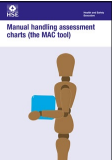
INDG 383 - Manual handling assessment charts (the MAC tool)
Work-related musculoskeletal disorders (MSDs), including manual handling injuries, are the most common type of occupational ill health in the UK. It is important to remember that:
> there is a lot you can do to prevent them;
> preventative measures are often simple and cost-effective;
> you cannot prevent all MSDs, but where they occur, early reporting of symptoms, proper treatment and suitable rehabilitation are essential.
The Manual Handling Assessment Charts (MAC) is a tool aimed at employers, health and safety managers and safety representatives and is used by health and safety inspectors. The tool will help you assess the most common risk factors in lifting (and lowering), carrying and team handling operations and was developed to identify high-risk manual handling.

INDG 384 - Five ways to reduce risk on site
For small construction sites
For small construction businesses
For workers

INDG 387 - Safe working with LPG-fuelled motor vehicles
Introduction
This leaflet tells you about the main health and safety risks associated with work on vehicles fuelled by liquefied petroleum gas (LPG) and the precautions that should be taken. It does not cover repair work on the LPG fuel system itself, nor does it cover vehicles fuelled with compressed natural gas (CNG).
Although there are specialist centres for installing and maintaining LPG systems, conventional vehicle servicing and repair work are normally carried out at motor vehicle repair (MVR) garages.
Vehicle recovery operators and breaking/recycling businesses will also have to deal with LPG vehicles.
This guidance is aimed at employers, self-employed people, supervisors and others likely to carry out any work which may affect LPG systems.

INDG 388 - Safety in isocyanate paint spraying
This leaflet is mainly aimed at owners, managers and supervisors of vehicle body-shops and also provides useful information for employees. It outlines the risks in using isocyanate paints (also known as 2K, two-pack or polyurethane paints) in motor vehicle repair and how you can minimise them by taking the right precautions.
The leaflet will also be useful to other industries where spraying of isocyanate containing paints and lacquers takes place.

INDG 390 - Choosing a welding set?
Introduction
This leaflet is aimed at employers, although suppliers of welding sets will also find it useful. It gives advice on identifying, managing and controlling the risks to your employees caused by handling welding equipment.
At the end of the leaflet there is an illustrated check-list to help you make the right choice when you select welding equipment.
Welding sets are becoming smaller and lighter. But if you need to regularly move the set by hand, you may need to include this task as part of your general handling risk assessment.

INDG 391 - Cadmium and you
Working with cadmium: Are you at risk?
Introduction
Working with cadmium and its compounds may affect your health. This leaflet tells you about the possible health hazards of different forms of cadmium, the preventative measures your employer needs to apply and the precautions you should take.
Bear in mind that not all forms of cadmium present the same dangers.

INDG 392 - Guidance for the recover paper
Background
Recycling is a specialist industry which is rapidly expanding because of the need to reduce the amount of waste sent to landfill. This guidance has been produced by the Health and Safety Executive (HSE) following concerns about the high numbers of serious and fatal accidents to employees in the recovered paper industry.

INDG 398 - Making the best use of lifting and handling aids
Frequent and heavy lifting and handling can cause back injuries. But using lifting and handling aids can remove or reduce that risk and keep workers healthy and at work.
This guidance is intended for managers, employees and their representatives and others involved in the selection of lifting and handling aids.
Why are back injuries an issue?
Back injuries from manual handling are a major cause of occupational ill health in the UK. But:
> they can often be prevented;
> preventative measures can be cost-effective;
> where back injuries occur, early reporting of symptoms, proper treatment and suitable rehabilitation is essential.
There are health and safety benefits for employers if they control manual handling risks by the use of lifting and handling aids such as:
> improved/maintained productivity;
> reduction in retraining costs;
> limiting the options for liability;
> reduction of injury/ill health to employees.

INDG 399 - Managing sickness absence and return to work in small businesses
(withdrawn - archive copy)
For small employers, an employee off work sick for more than 14 days is likely to be rare. But when it does happen, there are considerable benefits from working in partnership with your employees and their trade union and other employee representatives to help those off work sick to return to work.
Help file v1.175.0619 : Copyright © 2024 Brian G. Welch MSc(QHSE), NVQ4(OH&S), CMIOSH - Supported by Website On Safe Lines

